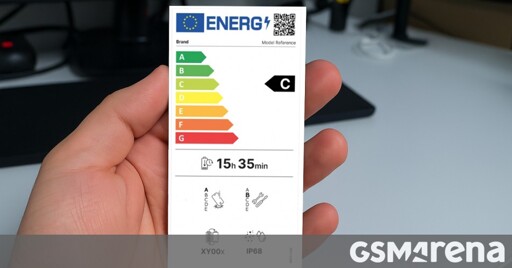- cross-posted to:
- android@lemdro.id
- cross-posted to:
- android@lemdro.id
- Durability: Devices should be resistant to accidental drops and protected against dust and water.
- Battery longevity: Batteries must endure at least 800 full charge and discharge cycles while retaining at least 80% of their original capacity.
- Repairability: Manufacturers must make critical spare parts available within 5 to 10 working days, and continue offering them for 7 years after the product is no longer sold in the EU.
- Software support: Devices must receive operating system upgrades for at least 5 years from the end-of-sale date.
- Repair access: Professional repairers must have non-discriminatory access to any required software or firmware.
IMO the Repairability scale should be the main (largest) indicator on the card… that’s the biggest impact in both TCO and environmental impact.
As I understand it, the energy efficiency class is based on how long the device works with a full charge. They have laid out a test cycle that needs to be repeated until the device turns off. The rest of the information on that label is just for your information.
One problem I can see with this is that it pushes manufactures to set as high maximum charge level, and as low minimum charge level for the battery as possible. What is “full” and “empty” for a battery is something that the manufacturer sets. The higher the “full” level is, and the lower the “empty” level is, the more stress is caused for the battery, which leads to the battery dying sooner. If you for example limit battery charging to 80% charge level, you can double the expected lifetime of a lithium battery. But this rating system doesn’t take that in consideration. It’s up to the consumer to choose between Class A device with 500 cycle battery and Class B (or something) device with 1000 cycle battery.
The EU now mandate that smartphones and tablets must be repairable, with parts like batteries, cameras, displays to be available for 7 years from the time the device enters market.
They use so little energy, I don’t think it makes sense to have a label for them…
I’d like to know more about expected battery life though, now mAh is often the only if you get.
I kind of agree. I use accubattery on my phone since I got it so I know more or less how much I have used to charge it.
1526593mAh over almost 4 years. If we assume 3.9V charge voltage (about average between CV/CC and I only charge it to 80%), then it is a bit under 6kWh consumed, which is under 2€ with our high electricity prices here.
It uses literally a rounding error of power over its entire lifespan.
However, having a standard way to test battery life and battery cycle longevity in phones would be very helpful, but I am 99% sure it would be an unrepresentative test that manufacturers would start gaming within a year or two to have very skewed results.
They all suck.
The Tank 3 Pro would like a word
Thanks for sharing. Yes that has a big battery but what is the battery life and efficiency? That’s what this article about. I’m sure if you can’t turn off that L5 GPS, that battery will drain quicker. Also the article and the product site doesn’t mention about any test nor stats on efficiency. So… good try for now?







